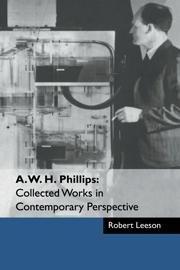Book contents
- Frontmatter
- Contents
- List of contributors
- Foreword by Arthur Brown
- Preface by Robert Leeson
- Part I Bill Phillips: Some Memories and Reflections
- Part II The Phillips Machine
- 8 The origins of the machine in a personal context
- 9 The Phillips Machine as a ‘progressive’ model
- 10 Mechanical models in economic dynamics
- 11 The history of the Phillips Machine
- 12 Early reactions to Mark I and II
- 13 A superb explanatory device
- 14 The Phillips Machine and the history of computing
- Part III Dynamic Stabilisation
- Part IV Econometrics
- References
- Index of names
- Index of subjects
14 - The Phillips Machine and the history of computing
Published online by Cambridge University Press: 04 May 2010
- Frontmatter
- Contents
- List of contributors
- Foreword by Arthur Brown
- Preface by Robert Leeson
- Part I Bill Phillips: Some Memories and Reflections
- Part II The Phillips Machine
- 8 The origins of the machine in a personal context
- 9 The Phillips Machine as a ‘progressive’ model
- 10 Mechanical models in economic dynamics
- 11 The history of the Phillips Machine
- 12 Early reactions to Mark I and II
- 13 A superb explanatory device
- 14 The Phillips Machine and the history of computing
- Part III Dynamic Stabilisation
- Part IV Econometrics
- References
- Index of names
- Index of subjects
Summary
I first saw a working Phillips Machine at the LSE on 19 September 1991. The occasion was the formal handover of one of two restored LSE Phillips Machines to the New Zealand Institute of Economic Research (Stern 1992). James Meade and Walter Newlyn, figures inseparably linked with the history and folklore of the Phillips Machines, were pre- sent, as were Reza Moghadam and Colin Carter, who had played a major part in the restoration; Moghadam and Carter 1989). The machines were coupled together, and run. The uniting of the two machines, one a mirror image of the other, recreated demonstrations by James Meade in the 1950s of the interaction of two national economies. As before, much gurgling and sloshing ensued to the inevitable delight of the audience.
The sight of the Phillips Machines spurred an approach by the Science Museum in London to acquire the remaining LSE machine. Negotiations between the two institutions exposed a moral conflict. Some staff of the LSE were clearly attached to the machine. It was a memento of a member of their community for whom there is much personal affection. It was also the focus of institutional pride in one of its distinguished sons and there was an emotional reluctance to let go as though parting with the machine would be severing a link with a past. On the other hand, the small community of those familiar with Phillips and the history of his eponymous machine was dispersing and his surviving contemporaries were no longer in their prime.
- Type
- Chapter
- Information
- A. W. H. Phillips: Collected Works in Contemporary Perspective , pp. 120 - 126Publisher: Cambridge University PressPrint publication year: 2000
- 6
- Cited by



